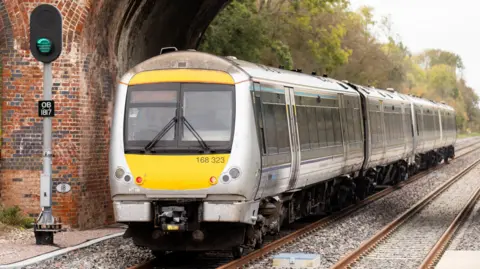What is happening with East West Rail?
 Network Rail
Network RailCambridge and Oxford are often linked as university cities but there has not been a direct, physical railway connecting them for decades.
The East West Rail (EWR) project will change that, linking the two via Bedford, Milton Keynes and Bicester.
But with a change of government, is the rail link still on track?
Is East West Rail still happening?
The short answer is yes.
The government committed to it in the Budget in October 2024 when the Chancellorof the Exchequer, Rachel Reeves, said: "We will deliver East-West Rail to drive growth between Oxford, Milton Keynes and Cambridge with the first services running between Oxford, Bletchley and Milton Keynes next year and trains between Oxford and Bedford running from 2030."
It also announced a public consultation on the next stage of the project, which involves trains to Cambridge.
Where does the East West Rail go?
The line aims to connect Cambridge and Oxford via Bedford, Milton Keynes and Bicester.
New stations would be built at Winslow, Tempsford and Cambourne - and Bedford St Johns station would be moved closer to Bedford hospital.
The route would also allow passengers to connect with the East Coast Mainline, Midland Mainline and West Coast Mainline.
Details released on 14 November as part of a 10-week consultation, said a number of stations on the railway between Bletchley and Bedford could be closed and a some may need to be consolidated or built to offer more services.
In Cambridgeshire, it was announced two new tunnels are proposed and Cambridge station would be renovated with trains to turn around at nearby Cherry Hinton "to ease pressure".
A full timetable has not yet been finalised but designs showed that external trains would run from 06:00 to 00:00 on Monday to Thursday, ending an hour later on Fridays and Saturdays.
On Sundays, services were planned for between 07:00 and 23:00.
EWR said it expected up to four trains per hour to run along the route.

When will East West Rail open?
Part of the line between Oxford and Bicester has already "opened".
The next phase will be running trains further north and east of Oxford, to Bletchley and Milton Keynes.
Trains are being tested at the moment and the first services are due to begin running in 2025.
The government has said that trains between Bedford and Oxford would run from 2030.
But completing the line all the way to Cambridge - Stage 3 of the project - would take much longer.
EWR says that before it can build the section between Bedford and Cambridge, it needs to apply for a development consent order, which is also needed to carry out other upgrades between Bedford and Oxford.
And before consent can be given, consultations need to take place with the public, landowners and local authorities that could be affected by the project.
How fast will East West Rail trains be?
The speed of the trains will depend on what section of track they are on, but the BBC believes they could reach a top speed of 100mph.
EWR said the journey between Cambridge and Oxford would take 90 minutes - an hour faster than by coach or car.
It said the train journey between Bedford and Cambridge is expected to take 35 minutes, compared to 75 minutes by car (or about 50-60 minutes according to Google Maps).
The company also said the link would reduce the traffic on local roads.
How much is East West Rail costing?
The Department for Transport is responsible for funding and overseeing the delivery of the EWR project.
As of March 2023, it is estimated the overall cost will be between £5.7bn and £6.6bn of public money.
But it is possible the final costs will rise.
Why is East West Rail not electrified?
Electrified railway lines produce fewer carbon emissions which is better for the planet.
But only part of the EWR rail line would be electrified - not all of it.
It will use hybrid-battery electric trains and overhead lines would only need to be installed on some sections of the route - which costs less.
EWR said this would also "reduce disruption during construction and potentially decrease visual impacts in more sensitive locations along the new railway".
Discontinuous electrification also would reduce the need to alter current structures and require less land for things such as mast foundations.
Is East West Rail part of Network Rail?
No, but they work closely together.
In 2018, the East West Railway Company was created by the Department for Transport to look at plans for the railway.
The EWR company is totally independent from Network Rail who own, operate, maintain and develop Britain's railways.
But both will be key in developing this line.
Where can I have my say on East West Rail?
A 10-week non-statutory consultation on the plans will run from 14 November 2024 to 24 January 2025.
"Non-statutory" means it is not legally binding but EWR says it will take feedback into account as it develops its designs.
You can take part online or attend one of the 16 drop-in consultation events which are being held across the route.
A statutory consultation will take place at a later date.
Allow Google YouTube content?
Follow East of England news on X, Instagram and Facebook: BBC Beds, Herts & Bucks, BBC Cambridgeshire, BBC Essex, BBC Norfolk, BBC Northamptonshire or BBC Suffolk.
